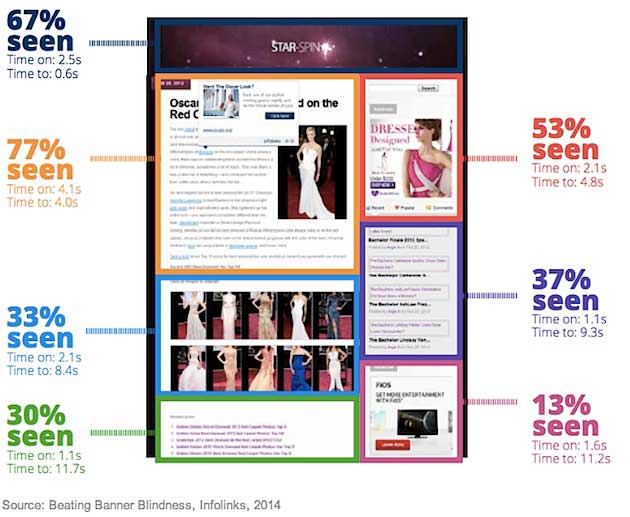Advertisers looking to boost the effectiveness of their digital display ads should be focusing on in-content units, nontraditional placements, contextually relevant creative, and above-the-fold locations, according to recent data from Infolinks.
The report was based on the results of an eye tracking study conducted by EyeTrackShop in 2013. Participants allowed researchers to access their webcams, which were then calibrated to track eye movements as webpages were viewed. Almost all of the respondents were under 40 (76% 18-30; 22% 31-40), and half were male, half female.
Below, key findings from the study.
Native Ads vs. Banner Ads
- Native ads—units delivered within core content areas—were seen 47% more quickly than banner ads in traditional locations on the same pages.
- Moreover, the time spent in the main content areas was 4,000% more than the time spent in the areas containing the banner ads, resulting in significantly higher brand recall.

Above the Fold
- Infolinks found conventional wisdom holds true: The top content area of a webpage (above the fold) does function significantly better than the bottom content area (below the fold) in terms of visibility ratio, time spent, and time to notice.
- In the study, 156% more people saw the top content area of the page compared with the bottom content area.
- However, being at the very top of the screen, where leaderboard ads are often placed, is not always beneficial. An ad unit at the bottom of the screen, just above the fold, was seen 225% more quickly than standard leaderboard ads at the top of the page—suggesting that users were skipping over the leaderboard placement, anticipating its irrelevance.

Non-Traditional Placements
- The study found ads delivered to unconventional page locations—at the edges, nestled between content areas, or integrated into navigational elements/search results—were more effective than ads located in traditional areas.
- In one test, respondents saw ads placed in the margins of a webpage 50% more quickly than standard display units on the page.

Relevance
- Placement was found to be an extremely important element in determining the effectiveness of display ads, but by no means the only factor. Relevance, in particular, also greatly affected the impact of the ads examined.
- In one test, an ad for the lesser-known brand fluless.com was recalled by 82% more people than an ad for AT&T/Android on the same page, likely because that the fluless.com ad was relevant to the page content (an article on the common flu).
About the research: The report was based on data from an eye-tracking study conducted by EyeTrackShop in 2013. Almost all of the respondents were under 40 (76% 18-30; 22% 31-40), and half were male, half female.




